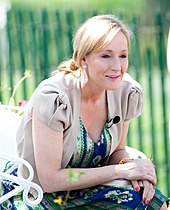
Joanne Rowling, known by her pen name J. K. Rowling, is a British author and philanthropist. She is the author of Harry Potter, a seven-volume fantasy novel series published from 1997 to 2007. The series has sold over 600 million copies, been translated into 84 languages, and spawned a global media franchise including films and video games. The Casual Vacancy was her first novel for adults. She writes Cormoran Strike, an ongoing crime fiction series, under the alias Robert Galbraith.
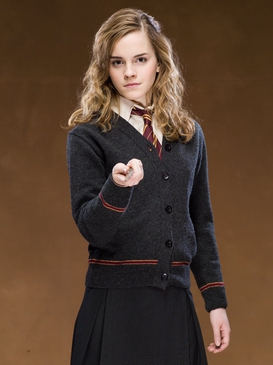
Hermione Granger is a fictional character in the Harry Potter series of novels by J. K. Rowling. She first appeared in Harry Potter and the Philosopher's Stone (1997), as a first-year student on her way to Hogwarts. She becomes friends with Harry Potter and Ron Weasley after they save her from a troll in the girls' bathroom. Hermione often uses her quick wit, deft recall, and encyclopaedic knowledge to help her friends in perilous situations. Rowling has stated that Hermione resembles herself as a young girl, with her insecurity and fear of failure.

Hogwarts School of Witchcraft and Wizardry is a fictional boarding school of magic for young wizards. It is the primary setting for the first six novels in the Harry Potter series by J. K. Rowling, and also serves as a major setting in the Wizarding World media franchise.

Harry Potter and the Philosopher's Stone is a fantasy novel written by British author J. K. Rowling. It is the first novel in the Harry Potter series and was Rowling's début novel. It follows Harry Potter, a young wizard who discovers his magical heritage on his eleventh birthday when he receives a letter of acceptance to Hogwarts School of Witchcraft and Wizardry. Harry makes close friends and a few enemies during his first year at the school. With the help of his friends, Ron Weasley and Hermione Granger, he faces an attempted comeback by the dark wizard Lord Voldemort, who killed Harry's parents but failed to kill Harry when he was just 15 months old.

Fantastic Beasts and Where to Find Them is a 2001 guide book written by British author J. K. Rowling about the magical creatures in the Harry Potter universe. The original version, illustrated by the author herself, purports to be Harry Potter's copy of the textbook of the same name mentioned in Harry Potter and the Philosopher's Stone, the first novel of the Harry Potter series. It includes several notes inside it supposedly handwritten by Harry, Ron Weasley, and Hermione Granger, detailing their own experiences with some of the beasts described, and including inside jokes relating to the original series.
In the fictional universe of Harry Potter, magic is depicted as a supernatural force that overrides the laws of nature. In humans, magical ability is inborn and is usually inherited. Most children of magical parents are magical themselves. Some children of "Muggle" (non-magical) parents also display magical ability. Children who are born to wizard parents but are unable to perform magic are known as Squibs.
The Wizarding World contains numerous settings for the events in the novels, films and other media of the Harry Potter and the Fantastic Beasts series. These locations are divided into four main categories: residences, education, business, and government.
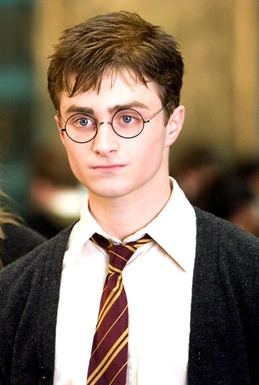
Harry James Potter is the titular character of the Harry Potter series of novels by J. K. Rowling. The plot of the seven-book series chronicles seven years in the life of the orphan Harry, who, on his eleventh birthday, learns he is a wizard. He attends Hogwarts, a school of magic, where he receives guidance from the headmaster Albus Dumbledore and becomes friends with Ron Weasley and Hermione Granger. Harry learns that during his infancy, the Dark wizard Lord Voldemort murdered his parents but was unable to kill him as well. The plot of the series revolves around Harry's struggle to adapt to the wizarding world and defeat Voldemort.
The following is a list of magical objects that appear in the Harry Potter novels and film adaptations.
A variety of magical creatures are depicted in the fictional universe of Harry Potter, which is drawn from various types of media. Magical creatures appear in the Harry Potter novels and their film adaptations, in the Fantastic Beasts film series, in other books by J. K. Rowling, and on the website of the Wizarding World media franchise. In 2001, Rowling released Fantastic Beasts and Where to Find Them, which serves as a guidebook to the creatures described in the fictional universe. Some of these creatures were invented by Rowling. Others are derived from sources such as Greek mythology, English and Celtic folklore, and the works of Roman historians.
The fictional universe of the Harry Potter series of novels contains two distinct societies: the "wizarding world" and the "Muggle world". The term "Muggle world" refers to a society inhabited by non-magical people ("Muggles"), while the term "wizarding world" refers to a society of wizards that live parallel to Muggles. The wizarding world is described as a veiled society wherein magic is commonly used and practised; the wizards live in self-enforced seclusion and hide their abilities from Muggles. The novels are set in 1990s Britain, which contains both Muggle and wizard communities. Any new works taking place in this universe are released under the Wizarding World brand.

Harry Potter is a series of seven fantasy novels written by British author J. K. Rowling. The novels chronicle the lives of a young wizard, Harry Potter, and his friends, Hermione Granger and Ron Weasley, all of whom are students at Hogwarts School of Witchcraft and Wizardry. The main story arc concerns Harry's conflict with Lord Voldemort, a dark wizard who intends to become immortal, overthrow the wizard governing body known as the Ministry of Magic, and subjugate all wizards and Muggles.
Writer J. K. Rowling cites several writers as influences in her creation of her bestselling Harry Potter series. Writers, journalists and critics have noted that the books also have a number of analogues; a wide range of literature, both classical and modern, which Rowling has not openly cited as influences.
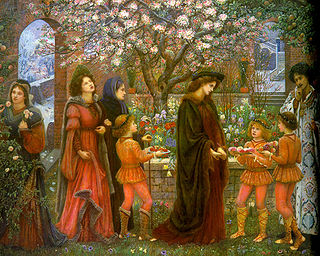
A magician, also known as an archmage, mage, magus, magic-user, spellcaster, enchanter/enchantress, sorcerer/sorceress, warlock, witch, or wizard, is someone who uses or practices magic derived from supernatural, occult, or arcane sources. Magicians enjoy a rich history in mythology, legends, fiction, and folklore, and are common figures in works of fantasy, such as fantasy literature and role-playing games.
Harry Potter is a series of fantasy novels by J. K. Rowling.
Religious debates over the Harry Potter series of books by J. K. Rowling are based on claims that the novels contain occult or Satanic subtexts. A number of Protestant, Catholic, and Eastern Orthodox Christians have argued against the series, as have some Muslims. Supporters of the series have said that the magic in Harry Potter bears little resemblance to occultism, being more in the vein of fairytales such as Cinderella and Snow White, or to the works of C. S. Lewis and J. R. R. Tolkien, both of whom are known for writing fantasy novels with Christian subtexts. Far from promoting a particular religion, some argue, the Harry Potter novels go out of their way to avoid discussing religion at all. However, the author of the series, J. K. Rowling, describes herself as a Christian, and many have noted the Christian references which she includes in the final novel Harry Potter and the Deathly Hallows.

Rubeus Hagrid is a fictional character in the Harry Potter series of novels by J. K. Rowling. He was introduced in Harry Potter and the Philosopher's Stone (2001) as a half-giant who is the gamekeeper and groundskeeper at the wizarding school Hogwarts. He is a member of the Order of the Phoenix and eventually becomes the Care of Magical Creatures professor. Hagrid is portrayed by Robbie Coltrane in all eight Harry Potter films.
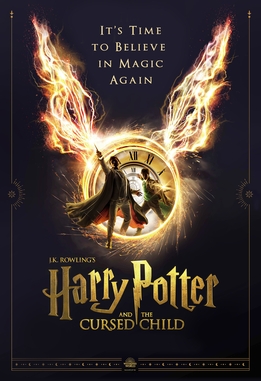
Harry Potter and the Cursed Child is a play written by Jack Thorne from an original story by Thorne, J. K. Rowling, and John Tiffany. The plot occurs nineteen years after the events of Rowling's novel Harry Potter and the Deathly Hallows. It follows Albus Severus Potter, the son of Harry Potter, who is now Head of the Department of Magical Law Enforcement at the Ministry of Magic. When Albus arrives at Hogwarts, he gets sorted into Slytherin, and fails to live up to his father's legacy, making him resentful of his father. Rowling has referred to the play as "the eighth Harry Potter story".
Harry Potter: A History of Magic is an exhibition of real-world magical artefacts and history presented alongside artefacts from the development of J.K. Rowling's fictional Harry Potter series. The exhibition originally opened at the British Library in 2017, as part of celebrations for the 20th anniversary of the publication of Harry Potter and the Philosopher's Stone. It is also available online through the Google Arts & Culture platform and was presented at the New-York Historical Society beginning in October 2018. Two official publications, Harry Potter: A History of Magic and Harry Potter: A Journey Through a History of Magic, along with a BBC television documentary, were created in conjunction with the exhibition.
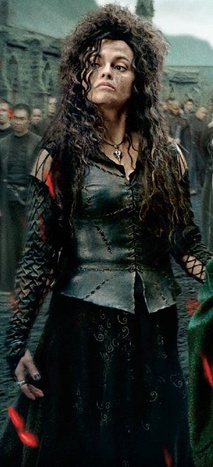
Bellatrix Lestrange (née Black) is a fictional character in the Harry Potter book series written by J. K. Rowling. She evolved from an unnamed peripheral character in Harry Potter and the Goblet of Fire into a major antagonist in subsequent novels. In the final installment of the story, Rowling established her as Lord Voldemort's "last, best lieutenant". Bellatrix was the first female Death Eater introduced in the books. Bellatrix had a fanatic obsession with the Dark Lord although she was clearly fearful of his magical abilities and absolute power over his forces. She is almost as sadistic and homicidal as Lord Voldemort, with a psychotic personality.

